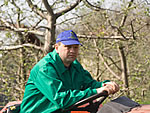 Fruit growing has been the mainstay of the rural parts of Drambovita County in Eastern Romania for generations.
Fruit growing has been the mainstay of the rural parts of Drambovita County in Eastern Romania for generations.
Florin has high hopes that the hard work will pay off. “I’m hoping that in five years we will have a totally different situation here,” he adds. “It’s my mission to help as many people as possible, to develop the area and its infrastructure.”
The geographic features of the region – the soil, climate and rainfall – are ideal for this type of farming, however the economic conditions are not so favourable.
Many young people from the area are abandoning the country life and moving to cities and towns. But Florin Istrate is one local bucking this trend. He is proud of the region where he has lived all his life and is working hard to improve the situation for himself and others.
The son of small-scale fruit farmers, he learned how to work the land from a young age. “Fruit growing has been the most important thing in this area for generations. It was natural for me to continue this work,” says the 39-year-old. “This is one of the few areas where fruit growing is still developing. We are bringing in new techniques and I want to be part of this development.”
When he eventually took over his family’s farm, he bought more land and planted more orchards – mainly apples and some pear trees. “We currently produce around 70 tonnes of apples per year,” he says, adding that he wants to expand further in future.
But farming on its own is not enough to provide a living for him, his wife and 10-year-old son. He has used his knowledge and experience in the sector to become an agricultural insurance assessor.
“When insurance brokers sell policies to farmers, I check that everything is correct,” he says. “You need to have specialist knowledge of farming and local contacts.”
Taking the initiative
Florin also plays a leading role in the regional and national farmers’ unions, and is Vice President of the national Romanian agricultural trade federation, AGROSTAR. He is involved in many activities which are trying to develop the regions and help small farmers create viable livelihoods for themselves. “I want to convince people not to leave. I tell them how to develop their businesses,” he says.
“I’m working to gather together farmers who sell the same produce to work in co-operatives,” he continues. “At the moment, our production is big but we don’t have the right conditions to store and package fruit. I want to improve this.”
In recent years, Florin has been visiting other areas in Europe. “We are running a project with partners from Galicia Region in Spain,” he says. “We have seen how they run their businesses there and are organising training to spread this knowledge.” Topics they look at are storage, packaging and negotiating with supermarkets.
“I saw that our natural conditions are perhaps better than Spain, but we can’t use them. We have problems with our infrastructure – for example the road networks,” he adds.
Training
In early 2009, he became the regional coordinator of a project to further develop this rural area. The initiative, co-funded by the European Union through the European Social Fund, provides training and information to the community. It aims to help people increase their incomes from farming and diversify into other sectors.
“The project helps farmers evolve from growing just for themselves towards selling their produce and building businesses,” he says. Up to 750 farmers from four areas in Romania will attend various courses, over a three-year period. Modules focus on five areas:
- Developing artisanal businesses;
- The transport and distribution of agricultural products;
- Hotels and development of rural tourism businesses;
- Developing hunting and fishing businesses;
- Developing services for social welfare.
Florin has high hopes that the hard work will pay off. “I’m hoping that in five years we will have a totally different situation here,” he adds. “It’s my mission to help as many people as possible, to develop the area and its infrastructure.”
